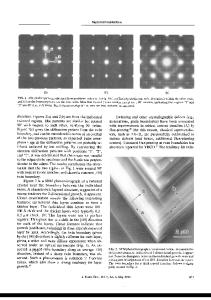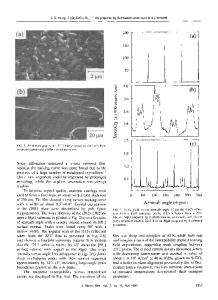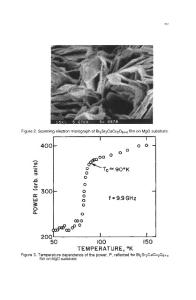Highly Textured Superconducting Bi 2 Sr 2 CaCu2Oy Crystals Prepared by Unidirectional Solidification Processing
- PDF / 1,474,985 Bytes
- 4 Pages / 420.48 x 639 pts Page_size
- 35 Downloads / 268 Views
HIGHLY TEXTURED SUPERCONDUCTING Bi2Sr2CaCu2Oy CRYSTALS PREPARED BY UNIDIRECTIONAL SOLIDIFICATION PROCESSING Y. SHIOHARA, T OYAMA, M. NAKAGAWA, T. SUGA, K. ISHIGE, T. IZUMI, S. NAGAYA, M. MIYAJIMA, I. HIRABAYASHI, AND S. TANAKA Superconductivity Research Laboratory, ISTEC, 1-10-13 Shinonome, Koto-ku, Tokyo 135, JAPAN ABSTRACT Unidirectional solidification processing, including Floating Zone Melting, Vertical Bridgman , and Laser Zone Melting methods for making high Tc superconducting oxides has been investigated. The effects of processing parameters, growth rate (R) and temperature gradient (G), on texture, morphology, and structures of unidirectionally grown crystals were investigated. Two different crystallization mechanisms were recognized, one is non-equilibrium phase transformation under high GR conditions, and the other is due to local equilibrium phase transformation under low GR conditions. Strongly aligned structures were obtained at high G/R ratios with low GR value. The interrelation between the superconducting characteristics and textured structure produced were also discussed.
INTRODUCTION Following the discovery of high Tc superconducting oxides [1,2,3], enormous research and development efforts have been stimulated because of the potentially immence technological impact of these novel materials. Several processes developed to date have yielded large and high quality crystals which have been useful for property studies. While the exact nature of the weak-link problem in sintered bulk superconducting oxides is still under further investigation, the potential importance of the meltingsolidification processing route was revealed subsequently by the high critical currents demonstrated by Jin et aL.[4] in texturedYBa 2Cu 30 7 x materials produced by the "melt-textured growth" (MTG) process and by Murakami et al. [5,6] as well through the "quench and melt growth" (QMG) process. Feigelson et al. [7] also reported results for the Bi-Sr-Ca-Cu-O system that clearly demonstrated the feasibility of growing textured fibers of superconducting oxides by the "pedestal" floating zone process. Brody et al. [8] demonstrated the laser heated float zone processing showing great promise for preparing single crystals and/or highly textured superconductors. Recently, Levinson et al. [9] reported J, = 450A/cm 2 at 77K in the thick films as processed by laser zone melting with rather slow beam scanning, and improved to 2200 Aanc2 by post processing anneal. In the present paper, specifically the following solidification processes are reviewed and discussed from solidification and crystallization standpoints based on our recent experimental studies on Bi-Sr-CaCu-O system: (i) vertical Bridgman unidirectional solidification method, (ii) halogen lamp heated float zone processing, and (iii) laser heated rapid zone melting processing.
EXPERIMENTAL Highly aligned polycrystals were produced by unidirectional solidification techniques, including the Bridgman method, the halogen-lamp heated floating zone (FZ) method, and a laser heated
Data Loading...











